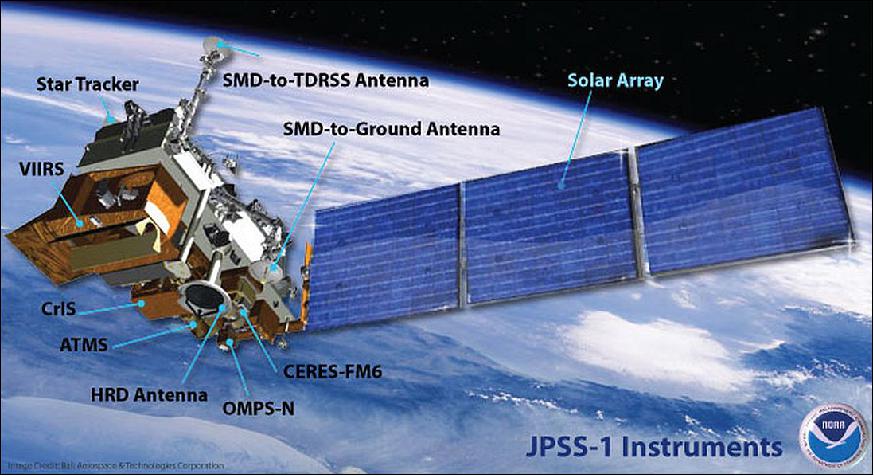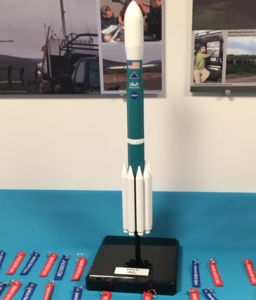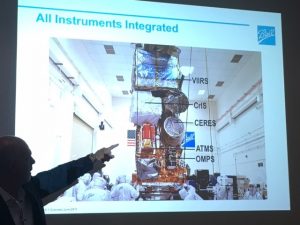
The Joint Polar Satellite System (JPSS for short) is a joint venture between the National Oceanic and Atmospheric Administration (NOAA) and the National Aeronautics and Space Administration (NASA.). Though there are many goals and uses for this particular satellite, for the meteorological community, the most important factor will be the ability to acquire advanced and numerous types of vertical data from the top of the atmosphere all the way down to the surface of the Earth twice a day over every single location on Earth. This acquired, advanced atmospheric data will then be fed directly into various computers with the ultimate goal of sizable and noticeable improvements to computer models that meteorologists use every day in making weather forecasts.
The satellite is being put together and manufactured by Ball Aerospace and Technologies Corporation in Broomfield, CO. The “-1” part of the name is from the fact that it is the first of four of these satellites that will be launched over the next 15 years. The anticipated launch date for JPSS-1 is September 21st of this year from Vandenburg Air Force Base in California. The launch of JPSS-1 and other mini-satellites on the payload onboard a United Launch Alliance (ULA) Delta 2 rocket has been pushed back twice, originally scheduled for January and then March and finally to September of this year due to concerns that arose during Ball Aerospace’s exhaustive, multi-step environmental testing procedures. According to Ball Director of Marketing and Communications Jackie Berger, “We continue to work closely with NOAA, the NWS and the contractor teams to achieve the September 21, 2017 launch date.”

According to Dr. Alexandra Lockwood, Communications Specialist for NOAA, the JPSS-1 is a polar orbiting satellite. “These types of satellites map out the Earth analogous to how a potato peeler works on a potato, as a slight slant in the satellite’s orbit allows it to completely map out every location on the Earth twice a day. The JPSS-1 will replace an experimental satellite called the Suomi National Polar-orbiting Partnership. Once JPSS-1 is in orbit, data will begin transmitting almost immediately though the data will not be used for several months so NOAA and NWS data analysts can examine the information coming in and confirm that it is accurate.”
There are 5 separate, high-tech “pieces” to the JPSS-1 but meteorologists are most interested in 3 of them, the Visible Infrared Imager Radiometer Suite (VIIRS), the Cross-track Infrared Sounder (CrIS) and the Advanced Technology Microwave Sounder (ATMS). These 3 devices will work together to send back to Earth advanced atmospheric data that will be fed directly into the supercomputers that our government uses to run the U.S. based computer weather models. Greg Mandt, Director of the NOAA side of the JPSS, compared the data that JPSS will be able to acquire to “launching thousands, if not millions, of weather balloons twice a day from nearly every location on Earth.”

Alex Chernushin, the JPSS-1 Program Manager, described the features of the satellite at a media event held on Monday. Chernushin said that all parts of the JPSS project, from the manufacturing of the instruments to the eventual putting together of the satellite was “exhaustive and intense. No stone was left unturned, nothing was done hurriedly and no corners were cut.” He described a multi-step testing procedure that included putting the satellite and its instruments through extremely loud noises, a violent rocking and shaking test (both simulated the types of forces the satellite would experience in the rocket takeoff), extreme radiation levels (so this satellite would be able to withstand space weather events such as coronal mass ejections from the Sun) and even collisions from the ever-increasing problem of space junk. “Even though the JPSS-1 has the ability to withstand small, less-extreme collisions in orbit from various space junk, it also has the capability of avoiding larger collisions through a propulsion system,” Mr. Chernushin explained.
The satellite is equipped by batteries that have the ability to recharge thanks to the presence of solar panels that are able to be stretched out when the JPSS-1 is in the sunlight. “Even though the instruments on-board the JPSS-1 are incredibly high-tech, the power drain of all 5 of them is comparable to a toaster oven. So the battery system that that powers the instruments can be expected to last about 7 years, right around the time the 2nd JPSS is expected to be launched into orbit.”, explained Mr. Chernushin.
Though the meteorological aspects of this satellite are foremost in our minds, the other aspects and types of data can not be ignored. Some other advanced capabilities of JPSS-1 will be the detection and measurement of vegetation greenness and health, the color of the ocean and its radiation footprint, sea ice/snow cover depth and extent, volcanic ash plumes, fire and smoke coverage, tracking oil spills and even ozone measurement.